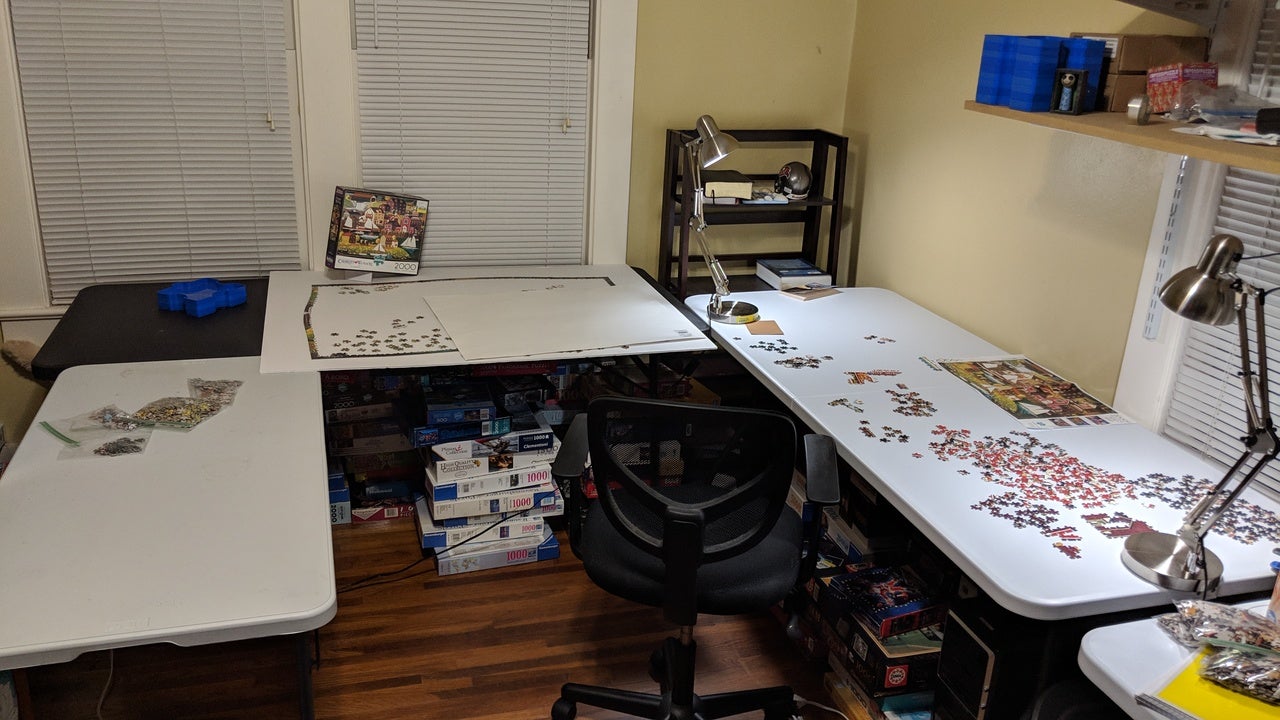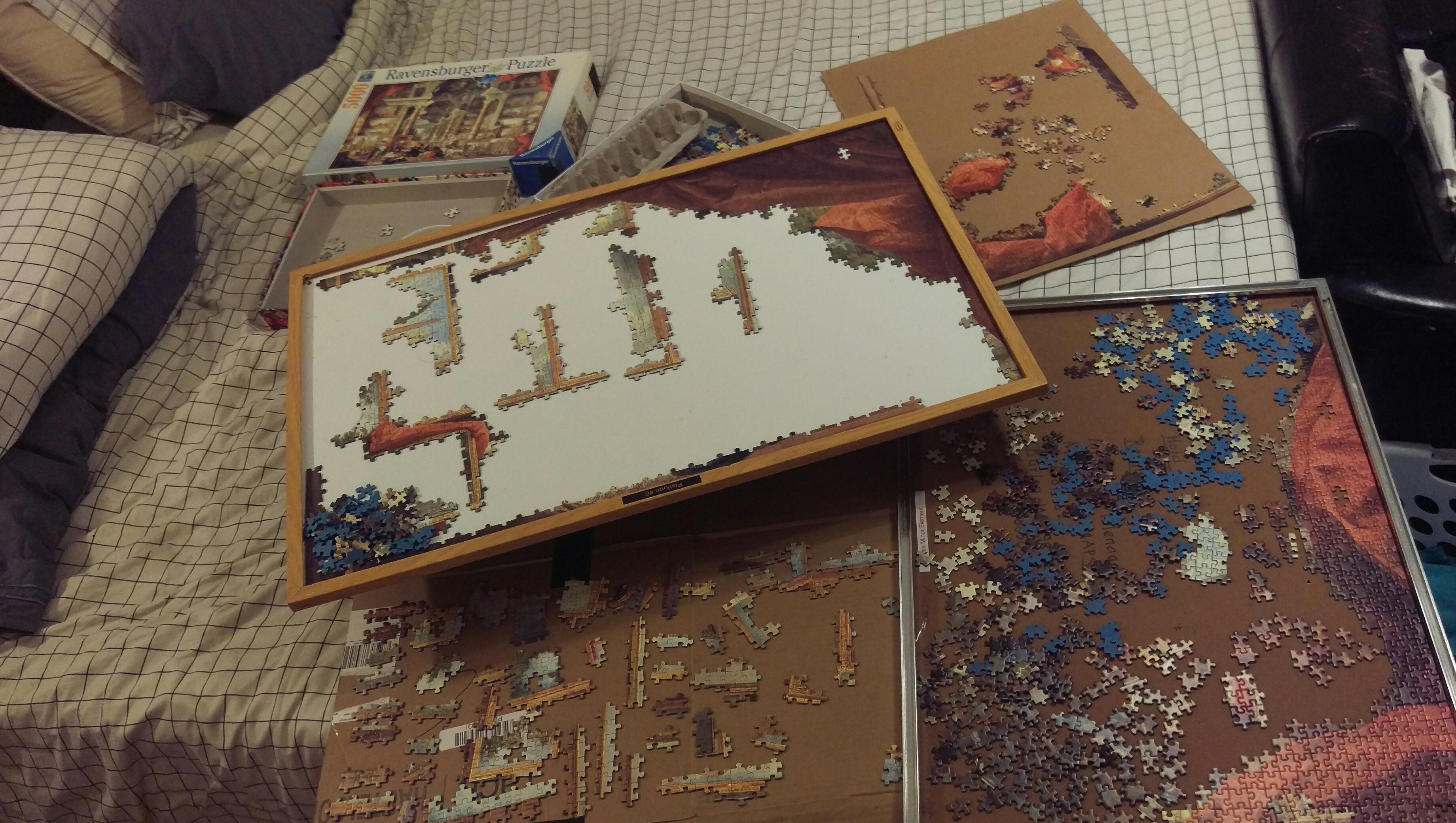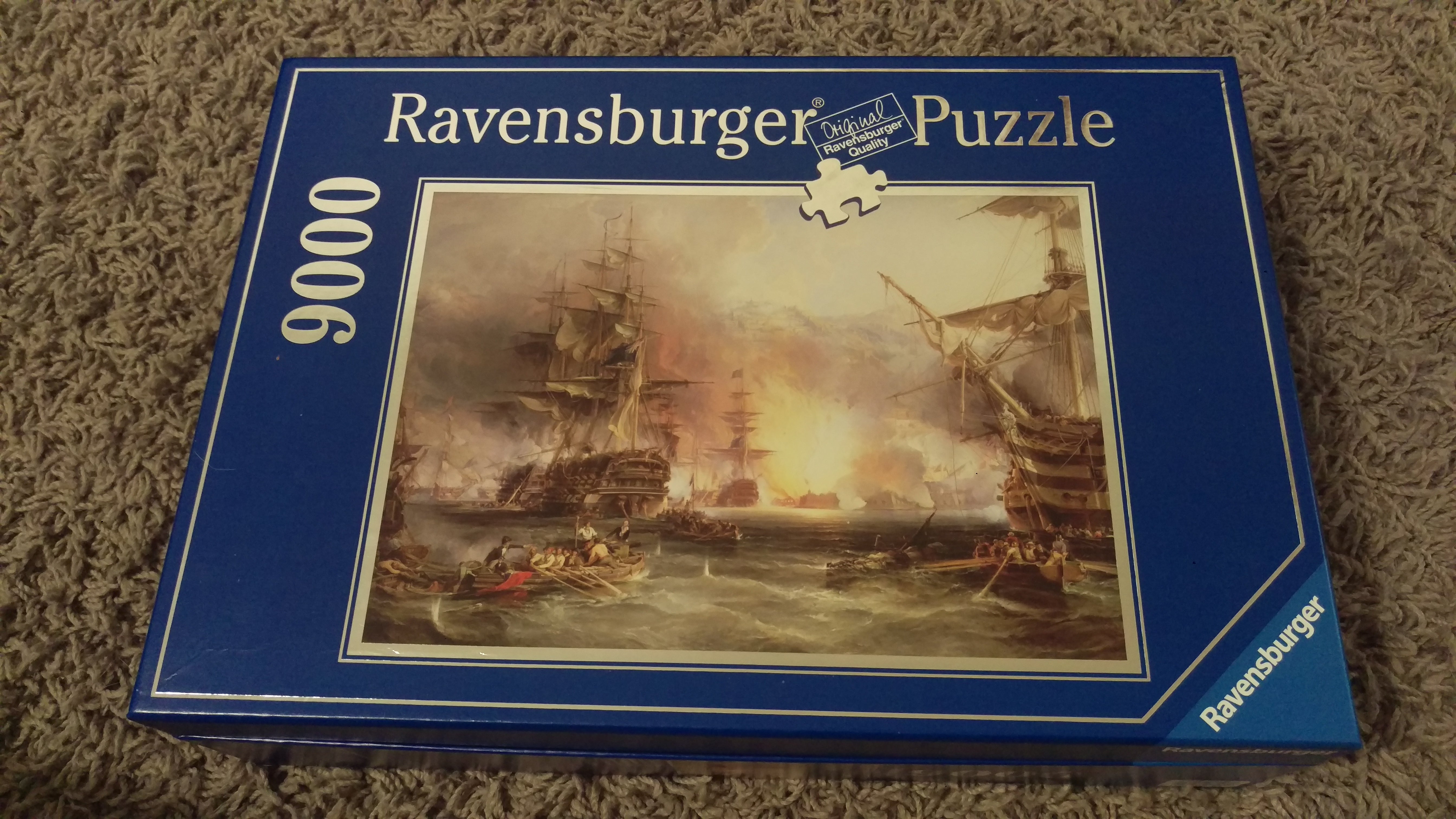On Christmas morning in 2017, Josh, a 42-year-old father of two daughters, received a gift he didn’t think much of at the time: a 300-piece puzzle. “I don’t remember ever doing a puzzle in my life,” he says. Then, after sitting down with his daughters to put it together that morning, he had a jigsaw reckoning.
“It completely LIT up my brain,” he writes. “When we finished, I beelined to Walmart and bought a 2,000-piece puzzle, the biggest one they had.”
Since that fateful morning, Josh has spent nearly $1,500 on puzzles, he estimates. “I’m hovering around 500 [puzzles] or so, including three [5,000-piece puzzles], two 9,000-, one 12,000-, two 18,000-, one 24,000- and a 32,000-piece puzzle. It’s obscene, I can acknowledge.”
Josh says he “put together a database to keep from buying the same ones over and over again,” adding the first time his daughters saw the puzzles piled up in his “puzzle room,” his 13-year-old “dryly said, ‘Oh, you have a problem.’”
“We can call a spade a spade,” he says about his space. “It’s a short step from a serial killer’s lair.”
But Josh hasn’t spent $1,500 on puzzles just for fun or to annoy his daughters — it helps curb his anxiety and focuses his ADHD. “My daughter and I were diagnosed [with ADHD] a few years back, and having learned what I’ve learned about it, this stuff all makes sense now.”
Josh says his ADHD lends him to obsessive behaviors, and puzzling is no different: “When I find something that really grabs me, it consumes me. ADHD makes it very difficult to pull out — not just [out] of the hobby, but the moment. The actual ‘stopping’ part is ridiculously hard.”
This helps explain why Josh compares puzzles to the thrill of whitewater rafting:
About 10 years ago, I went white-water rafting in Tennessee. I’m not a physical, outdoorsy kind of guy … but it was so exciting and so fun, and I realized that’s because it forced complete and total focus. There were four people in the raft and and a 20-year-old girl barking orders left and right. If I didn’t do exactly what she said, when she said, someone’s going in the water. There were no million-mile-an-hour thoughts about a hundred random things in my mind. Just quiet, clear focus. That’s what puzzling does for me, and that’s why it ignited my entire brain. You can’t half-ass a puzzle. You have to be in it or you’ll fail and quit. It’s a simple as that. There are colors, edges, shapes… it takes tremendous focus.
Dr. Claudia Luiz, a psychoanalyst author of the book The Making of a Psychoanalyst: Studies in Emotional Education, says it’s no accident that doing puzzles has such a profound effect on Josh. “Doing puzzles is extremely satisfying not only because you are solving something, but also because you can control achieving the positive outcome,” she tells MEL, adding that such an outcome triggers a double dose of dopamine — the brain’s favorite feel-good juice.
So for guys like Josh, whose attention deficit might lead to anxiety and racing thoughts, Luiz says the “two-part dopamine reward — having something you can control and getting a successful outcome — relieves the mind of feelings of powerlessness and hopelessness. … Feeling effective in light of a ‘problem’ is empowering, and provides relief.”
Josh isn’t the only adult man who’s found puzzles to quiet his busy mind. In fact, I spoke to several guys, including an Iraq War veteran with PTSD, who have giant puzzle rooms as well. Here’s what they love about it.
They asked for a harder puzzle. I present to you the worlds largest puzzle. from Jigsawpuzzles
Ravensburger 18000 piece. It took around 14 months from Jigsawpuzzles
Ryan, 25
I always have a large puzzle, usually 10,000-plus pieces, that sits on a table in my living room. I will consistently work on these puzzles after work to prevent myself from dreaming about Excel spreadsheets.
I began to puzzle as a means of learning patience when I was younger. I was quite the impatient teen and had difficulty developing long-term goals. As a college student, I realized they kept my mind occupied. Now as I have entered the workforce, I have a stressful job and the hours can be demanding for certain months of the year.
Some stresses for me can be easily eliminated, and for those that can’t, I enjoy doing a puzzle to keep my mind at bay. (Ironically one of the things that stresses me out the most is missing a puzzle piece. I recently tore apart my home only to find one in the vacuum cleaner.)
Overall I have probably spent around $2,000 on puzzles over five years. The way I think about it, is that I can pay $400 (in the case of the Disney puzzle) for something that will bring me joy, entertainment and stress relief for months or even years. Also, at the end, I have something beautiful to show for it. They do make for good pieces of art or wall decorations.
So the costs of the puzzles have never been a concern. I just budget expenses from other aspects of my life into my next puzzle — such as walking instead of taking Uber or deciding not to get fast food. Two meals of fast food can easily be the cost of a 1,000-piece puzzle or the cost of going to see a movie with popcorn.
When I browse the r/jigsawpuzzle subreddit, I sometimes find puzzles that I want to buy and instantly do. One of my recent smaller puzzles was of a black cat (“The Witching Hour”) as it reminded me of my cat Nox.
When you do a lot of larger puzzles, you get more skilled at organizing and sorting pieces, which I never thought would contribute to helping my own organization skills, but it has helped immensely.
Josh, 42

Outside of work, I’m usually working on a puzzle. In the morning for a couple of hours, I’m drinking coffee and waking up putting them together, in the evenings, unless I’m watching TV and the weekends. I figured at some point I’d burn out on it, but that hasn’t happened yet and I don’t know that it ever will.
Usually 500-piece puzzles take me two to three hours to a day, depending on how hard they are. Thousand-piece ones, maybe seven hours to a week, depending. Half of the $1,500 I’ve spent is from the larger puzzles. The others are generally $2 to $4 each at thrift stores.
Besides the first one, my 10- and 13-year-old daughters basically tell me to go F myself every time I try to get them to do one with me. But honestly, it will take me decades to do just the ones I have [accumulated] already, so there’s time.
As far as the what and why in the puzzles that I buy, I definitely like ones that are unique, for whatever reason. There are so many landscapes and country scenes out there. But there are also some really cool ones. Terrible and ironic, or just really cool art, I had one that actually disturbed me emotionally, so much that I threw it in the trash after I finished it.
I definitely would be filling the time with something less productive were it not for the puzzles. Hard to justify the extent that I’ve taken it, but either way ADHD means you’re always bored. I’m 42, I’ve never had something fully occupy me, and puzzles are a nice and cheap hobby overall. But I overconsume, like [with] anything.
David, 30
As corny and cliché as it sounds (and a little embarrassing too), doing puzzles changed my life and helped me get through the hard times.
I rediscovered puzzles just recently when my brother gifted my sister a puzzle from Disneyland for her birthday. I was bored one day and decided to help her out with it. It was too difficult, and I gave up trying to help her. A couple of months later I had an urge to put one together. The feeling came out of nowhere. After school some time this past October, I decided to stop at a Walmart, drive through rush-hour traffic and out of my way to pick up a puzzle. I haven’t stopped doing them since.
I was diagnosed with generalized anxiety disorder in late May of 2018, and doing puzzles definitely helps manage it. I had a series of anxiety attacks that appeared without warning. I saw a psychiatrist who was rather dismissive of my mental health and seemed to be interested in treating my symptoms with medication without attempting any other alternatives.
I began to learn how to manage the anxiety on my own through different platforms, but they all only sort of helped. Then my anxiety began to change and manifested into headaches. These headaches were strange. They were pulsating, they throbbed, and made me feel not as if the room were spinning but as if I were the one spinning.
Puzzles helped me through these headaches. I suppose the heavy concentration needed to put a puzzle together distracted me from thinking about the headaches. I haven’t had an anxiety attack since I buckled and started taking my medication (Sertraline), but I still get small flare ups of anxiety here and there. Doing puzzles during this time is the most helpful way to push the feeling of oncoming anxiety and the subsequent fear of having a full-blown attack away.
Friends and family are always baffled at how quickly I can complete a puzzle or how many I’ve completed in such a short time, but while people spend six to seven hours watching TV, I spend that time working on a puzzle.
It’s hard to estimate how much I’ve spent on puzzles since I started buying them, but it’s most likely between the $200–$300 range. I am a huge Disney fan, and as you know, Disney charges a premium for anything. Still, I can’t say I’ve spent an exorbitant amount of money — not compared to other people. I frequent thrift stores for puzzles where the price of a puzzle can range between 50 cents to about $5.
Chris, 35
I am an Iraq War vet, diagnosed with PTSD and anxiety, and I do tons of puzzles to chill out.
I have major issues with falling asleep, and [I] realized quickly that puzzles were helping me fall asleep easier without the aid of medication. So now I work on a puzzle almost every night before I fall asleep. They really helped me clear the chaos of the day out of my head and reach some quiet.
As far as cost goes, I’ll do pretty much any puzzle, so usually I can find good cheap thrift store puzzles for a few bucks a piece. Recently, though, I’ve been doing bigger Ravensburger 3,000-, 5,000- and 9,000-piece puzzles. So this winter I’ve spent around $200 on them.


I’ve been doing puzzles my whole life, but rediscovered them about a year ago when my wife and I picked up a couple at a thrift store. Now I have a puzzle going pretty much all the time, and even made little platforms so I can work on them in bed, which also helps me safely stash them to keep them away from my kids.

